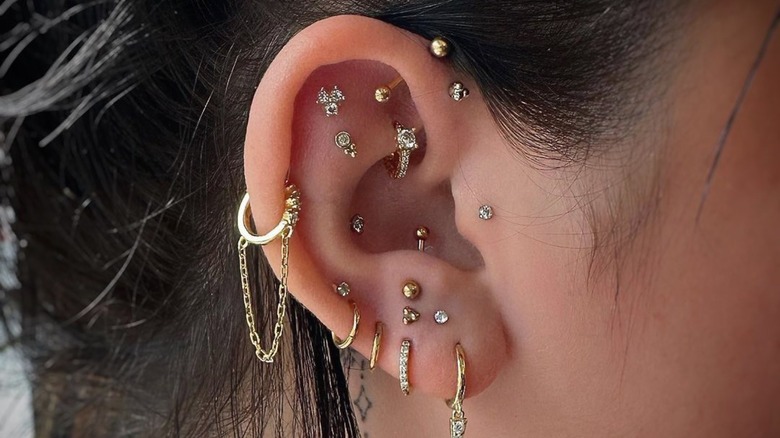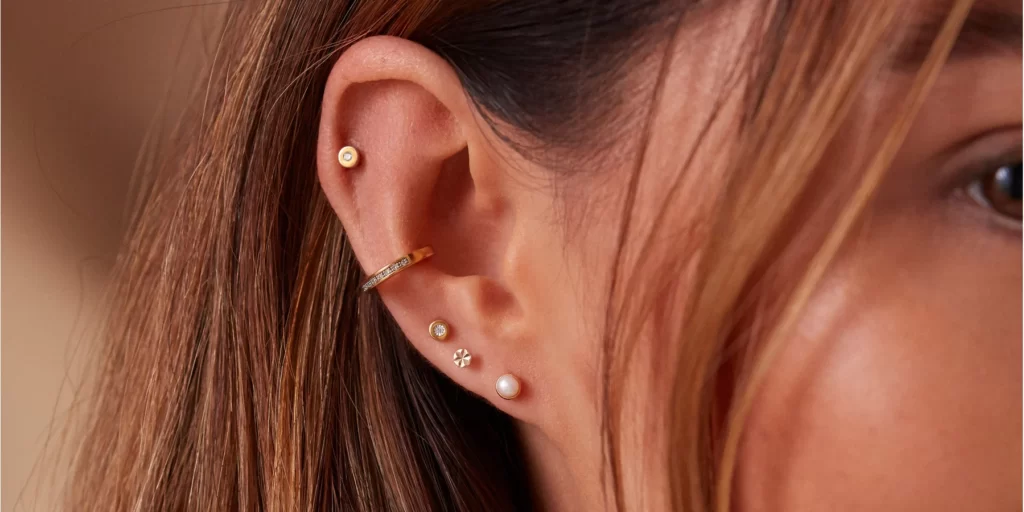Ear piercing is a procedure in which a small hole is created in the earlobe or another part of the ear using a sterile needle or piercing gun. This hole allows for the insertion of earrings or other types of jewelry. Ear piercing has been practiced for thousands of years and is a common form of body modification and adornment in many cultures.
Are you looking for piercing in Dubai? Serenity has prepared the best piercings for you. Contact our beauty clinic now to have an attractive look.
The process of ear piercing typically involves cleaning the earlobe or the area to be pierced, marking the desired location for the piercing, and then using a sterile needle to create the hole. In some cases, a piercing gun may be used instead of a needle, but it’s generally recommended to use a needle as it tends to be less traumatic to the tissue and carries a lower risk of complications.
After the piercing is done, the area may be slightly sore, red, or swollen for a few days. It’s important to keep the piercing clean and follow any aftercare instructions provided by the piercer to prevent infection. It usually takes several weeks to several months for the pierced hole to fully heal, during which time it’s important to avoid changing earrings or applying excessive pressure or trauma to the area.
Ear piercings can be done in various locations on the ear, including the earlobe, upper ear cartilage, tragus, helix, and other parts. Different types of earrings and jewelry can be worn in these piercings, ranging from studs and hoops to barbells and dangles. It’s important to choose high-quality jewelry made of hypoallergenic materials to minimize the risk of allergic reactions or other complications.
It’s worth noting that ear piercing should ideally be performed by a trained professional in a clean and sterile environment to minimize the risk of infection or other complications. If you’re considering getting your ears pierced, it’s a good idea to consult with a reputable piercer or a healthcare professional who can provide guidance and perform the procedure safely.
Nose Piercing :
Nose piercing is a type of body piercing that involves the insertion of jewelry, such as a stud or ring, into the tissue of the nose. It is a popular form of body modification and has been practiced in various cultures throughout history.
Belly Piercing :
Belly piercing , also known as navel piercing or belly button piercing, is a type of body piercing that involves the insertion of jewelry through the skin around the navel. It is a popular form of body modification and self-expression.

Benefit of ear piercing
Ear piercing is primarily done for aesthetic and cultural reasons, allowing individuals to wear earrings and other types of jewelry as a form of self-expression and adornment. However, there are a few potential benefits associated with ear piercing:
- Self-expression: Ear piercing allows individuals to express their personal style and enhance their appearance. It provides a way to accessorize and complement different outfits, hairstyles, or occasions.
- Cultural and traditional significance: In many cultures, ear piercing holds cultural or traditional significance. It may be performed as a rite of passage, symbolize social status, or reflect cultural identity and traditions.
- Fashion and trends: Ear piercing is often influenced by fashion trends and can be a way to stay current and fashionable. It allows individuals to experiment with different earring styles, sizes, and materials to suit their personal taste and follow the latest fashion trends.
- Psychological benefits: For some individuals, ear piercing can contribute to increased self-confidence and self-esteem. The act of piercing and wearing earrings can be empowering and help individuals feel more comfortable and satisfied with their appearance.
It’s important to note that the benefits of ear piercing are subjective and vary from person to person. It’s a personal choice and should be done with careful consideration of individual preferences, cultural significance, and the potential risks and aftercare requirements associated with the procedure.
ear piercing chart
Here’s a basic ear piercing chart that outlines common ear piercing locations:
- Earlobe Piercing: The most common type of ear piercing, done on the fleshy lower part of the earlobe.
- Helix Piercing: Located on the upper, outer rim of the ear.
- Forward Helix Piercing: Placed near the front of the upper ear, along the rim or just above it.
- Tragus Piercing: Positioned on the small, protruding cartilage in front of the ear canal.
- Anti-Tragus Piercing: Placed opposite the tragus, on the lower, outer cartilage of the ear.
- Conch Piercing: Situated in the middle part of the ear, either in the inner conch (closer to the ear canal) or the outer conch (closer to the edge of the ear).
- Industrial Piercing: Also known as a scaffold or bar piercing, it involves two holes connected by a long straight barbell. Typically, one hole is located on the upper ear cartilage, and the other is on the helix.
- Rook Piercing: Located on the inner ridge of the ear, above the tragus.
- Daith Piercing: Placed on the innermost fold of the ear cartilage, near the ear canal.
- Snug Piercing: Positioned on the inner cartilage ridge, along the anti-helix.
- Orbital Piercing: Involves two piercings connected by a single piece of jewelry, usually a ring. The two holes may be on the helix, lobe, or a combination of both.
It’s important to keep in mind that individual ear anatomy can vary, and not all piercing locations may be suitable or feasible for everyone. It’s best to consult with a professional piercer who can assess your specific anatomy and provide recommendations based on your preferences and safety considerations.



